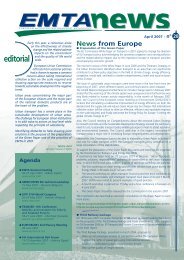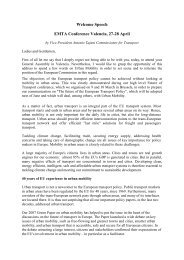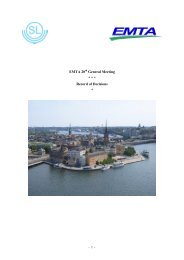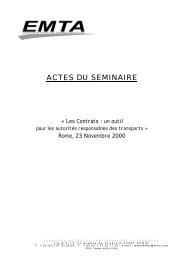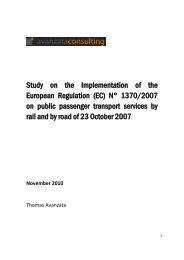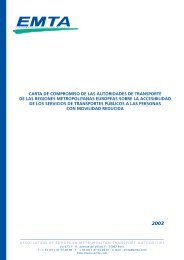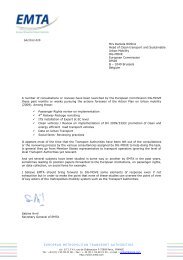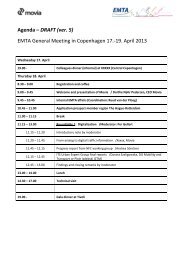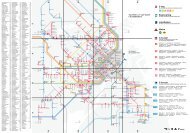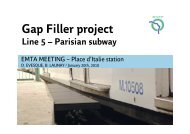Mobility Plans: the way forward for a sustainable urban ... - EMTA
Mobility Plans: the way forward for a sustainable urban ... - EMTA
Mobility Plans: the way forward for a sustainable urban ... - EMTA
Create successful ePaper yourself
Turn your PDF publications into a flip-book with our unique Google optimized e-Paper software.
transport measures and notably Urban<br />
<strong>Mobility</strong> <strong>Plans</strong>, mobility plans <strong>for</strong> trips to<br />
work (work travel plans) and <strong>the</strong> development<br />
of public transport by road. The Transport<br />
Authority CRTM is responsible <strong>for</strong> <strong>the</strong><br />
implementation of those plans.<br />
As of Warsaw it all started with <strong>the</strong> first<br />
transport policy document in 1995, <strong>the</strong>n<br />
completed with a Strategic Vision <strong>for</strong> <strong>the</strong><br />
development of <strong>the</strong> city towards 2020<br />
drafted by <strong>the</strong> City of Warsaw. In <strong>the</strong><br />
years 2007-2009, a new Strategy <strong>for</strong><br />
Sustainable Transport Development was<br />
drawn as a continuation of <strong>the</strong> above<br />
documents. The main point of <strong>the</strong> strategy<br />
is <strong>the</strong> <strong>sustainable</strong> transport development<br />
plan which unfolds into 2 goals. One is <strong>the</strong><br />
settlement of a metropolitan Transport<br />
Authority, in cooperation with <strong>the</strong> regional<br />
government, covering <strong>the</strong> main city and<br />
<strong>the</strong> surrounding municipalities 2 .<br />
The second is <strong>the</strong> modernization of <strong>the</strong><br />
transport system taking all modes simultaneously<br />
into account, with a view<br />
to upgrade (tram network), to extend<br />
(building of 2 metro line), to replace and<br />
“green” <strong>the</strong> vehicle fleets, to improve bus<br />
route conditions, and to achieve integration<br />
of fares and of sub-systems in a comprehensive<br />
<strong>way</strong> (eg integrate <strong>the</strong> sub<strong>urban</strong><br />
train services into <strong>the</strong> <strong>urban</strong> transport<br />
network). Warsaw working on <strong>the</strong> wider<br />
scope of Urban <strong>Mobility</strong>, adds measures<br />
concerning road safety, walking and cycling<br />
policies and contemplates <strong>the</strong> possibility of<br />
a road charging scheme but only after <strong>the</strong><br />
transport system has been improved.<br />
In Torino <strong>the</strong> situation was a preexisting<br />
overlapping of different levels of planning<br />
(from region, province and municipality)<br />
and a real expertise of <strong>the</strong> <strong>urban</strong> transport<br />
operator <strong>for</strong> <strong>the</strong> transport planning. The<br />
2 A draft-law is <strong>for</strong>eseen end of 2009.<br />
planning of transport services was handed<br />
onto <strong>the</strong> transport authority AMMT when<br />
created in 2003 by law. Interestingly <strong>the</strong><br />
scope is at once a metropolitan one<br />
(Torino city plus surroundings) and covers<br />
public and private transport modes.<br />
AMMT is also bound by <strong>the</strong> law to write<br />
<strong>the</strong> <strong>Mobility</strong> Plan. It started planning in<br />
2005 with a mobility and transport<br />
development plan that encompassed road<br />
traffic, Public Transport network, environmental<br />
impacts with appropriate assessments,<br />
<strong>the</strong>n articulated <strong>the</strong> document with o<strong>the</strong>r<br />
planning documents on rail<strong>way</strong> services<br />
and tariff integration.<br />
The context of Sheffield metropolitan area<br />
is <strong>the</strong> following: Public Transport Authorities<br />
PTAs have according to <strong>the</strong> law of 2000,<br />
to deliver along with 4 o<strong>the</strong>r partners<br />
(from high<strong>way</strong>, parking and land-planning<br />
administrations) <strong>the</strong> Local Transport Plan<br />
(LTP) that must be approved by regional<br />
partners <strong>the</strong>n given permission and funded<br />
by national government.<br />
The reason was first to pass down national<br />
funding of city regions to local areas <strong>for</strong><br />
implementing <strong>the</strong> LTP measures and<br />
second to contribute to <strong>the</strong> fulfillment of<br />
national targets about <strong>the</strong> air quality. First<br />
generation 2001-2006 of LTP was assorted<br />
with bonus mechanisms of “reward<br />
funding” which where felt incentive but<br />
disappeared with <strong>the</strong> second generation.<br />
All <strong>the</strong>se <strong>Mobility</strong> <strong>Plans</strong> somehow<br />
refer to a wider national strategy and<br />
not only do <strong>the</strong>y have to be compatible<br />
with national targets but <strong>the</strong>y even<br />
become an important tool at local<br />
level to fulfill <strong>the</strong> national ef<strong>for</strong>t<br />
in combating climate change and<br />
supporting economic and social<br />
challenges. ATM Barcelona also sees <strong>the</strong><br />
PDM as a tool to rationalize and consolidate<br />
various pre-existing separate<br />
sectoral plans. VBB Berlin-Brandenburg<br />
adds <strong>the</strong>se plans are very efficient tools<br />
that hold <strong>the</strong> whole transport strategies<br />
toge<strong>the</strong>r.<br />
<strong>Mobility</strong> plans are comprehensive documents.<br />
They cover main areas such as <strong>the</strong><br />
management and monitoring of regional<br />
mobility, <strong>the</strong> promotion of collective public<br />
transport and <strong>the</strong> enhancement of soft<br />
modes (walking and cycling) with a view<br />
to influence modal shift from private car to<br />
collective or non motorized means, <strong>the</strong><br />
transport and distribution of goods, and to<br />
a certain extent <strong>the</strong> planning of road<br />
traffic and <strong>the</strong> organization of parking<br />
(London, Barcelona, Torino). Targets are<br />
precise which relate to environment, to<br />
expected modal share, to noise. Guidelines<br />
are issued (in Barcelona and Madrid) to<br />
facilitate implementation of measures by<br />
local actors and in particular municipalities.<br />
And lastly, sets of indicators are elaborated<br />
to monitor progress and assess <strong>the</strong> results,<br />
<strong>for</strong> <strong>the</strong> emphasis must be put on delivery<br />
as Sheffield stresses, detailing <strong>the</strong> three<br />
axes of evaluation in <strong>the</strong> LTPs: about <strong>the</strong><br />
delivery of <strong>the</strong> announced scheme, about




